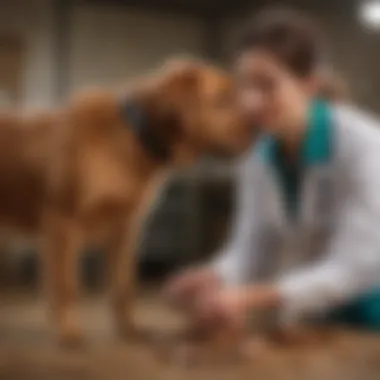Understanding Canine Distress: Panting and Diarrhea


Intro
Understanding canine distress can be a challenging endeavor for pet owners. It often requires an attentive ear and a watchful eye. Panting and diarrhea are two symptoms that may signal underlying health concerns in dogs. When these symptoms appear together, the situation can become alarming. This article aims to provide you with a comprehensive guide on the implications of these symptoms, their potential causes, diagnostic methods, and available treatment strategies.
Prompt veterinary evaluation is crucial when a pet shows signs of distress. Recognizing the symptoms early can lead to better outcomes. Plus, being knowledgeable about your dog's health can empower you as an owner to make informed decisions.
Understanding Your Pet
A dog's health is influenced by various factors. Two key areas to focus on are breed traits and common temperaments. The genetic background of your dog can impact its susceptibility to certain health issues.
Breed Traits
Different breeds exhibit unique characteristics and vulnerabilities. For instance, brachycephalic breeds like Pugs or Bulldogs may struggle with respiratory issues. This is significant when evaluating panting as a symptom. Likewise, larger breeds often face different health challenges compared to small breeds.
Common Temperaments
Understanding your dog’s temperament aids in recognizing unusual behavior. While all dogs may pant from excitement or stress, excessive panting or diarrhea can indicate distress. Noticing changes in behavior can alert you to potential health problems.
Special Needs
Each dog has its specific needs that can affect its overall health. Factors such as age, previous medical history, and pre-existing conditions should always be considered. Be observant about your dog's habits and health, as it helps to identify when something is amiss.
Pet Care Essentials
Care for your dog encompasses various aspects. Maintaining proper nutrition, grooming, and overall health ensures your pet thrives.
Nutrition and Feeding Guidelines
Providing balanced nutrition is fundamental. Dogs need specific vitamins and minerals for their well-being. Incorporating a diet that meets these needs aids in preventing health issues. Consult a veterinarian for tailored recommendations.
Grooming Tips and Techniques
Regular grooming is essential for hygiene and comfort. Brushing your dog’s coat helps remove dirt and prevent matting. Additionally, hygiene is crucial, especially if dogs experience diarrhea, as it can lead to skin irritations.
Health and Wellness
Routine veterinary check-ups are important. These visits allow veterinarians to monitor your pet's overall health and catch potential problems early. Vaccinations and preventive care are vital in ensuring a healthy life.
Training and Behavior
An informed approach to training can contribute to a well-adjusted pet. Training not only shapes behavior but also fosters a healthy relationship between owner and dog.
Basic Training Techniques
Utilizing positive reinforcement techniques promotes good behavior. Dogs respond well to rewards, whether treats or praise. Effective training can reduce anxiety, which may manifest as panting.
Behavioral Problems and Solutions
Identify any behavioral issues that may arise. Addressing these problems quickly can prevent them from escalating into distress-related symptoms. Consulting a dog trainer or behavior specialist can be beneficial.
Mental Stimulation Activities
Engaging your dog mentally is vital for its well-being. Activities that stimulate their mind help alleviate boredom. This can include puzzles or interactive toys that challenge their problem-solving abilities.
Engaging with Your Pet
Bonding with your pet enhances their quality of life. Involving your dog in daily activities can significantly improve their happiness and health.
Interactive Games and Toys
Playing games with your dog can strengthen your bond. Fetch or tug-of-war are simple activities that offer both physical exercise and mental engagement.
Safe Outdoor Activities
Exploring the outdoors together offers several benefits. Nature walks not only provide exercise but also expose your dog to new scents and experiences that can enrich its life.


Family-Friendly Pet Interactions
Encouraging family involvement with your dog can enhance social interaction. Teaching children how to interact gently with dogs fosters a respectful and loving relationship.
Pet Adoption and Integration
Adopting a pet is a significant commitment, requiring careful consideration. Ensuring a good fit between your lifestyle and the pet’s needs is vital for a harmonious life together.
Choosing the Right Pet for Your Lifestyle
Taking time to select the right breed and age can lead to successful adoption. Research various dog breeds and their characteristics to align with your family’s lifestyle.
Preparing Your Home for a New Pet
Creating a safe, welcoming environment is crucial for a new pet. Ensure that your home is equipped with necessary supplies, such as food, water bowls, and a comfortable place to rest.
Tips for Smooth Prologue
Introducing a new pet to your home requires patience. Gradual introductions to family members and existing pets can help ease the transition.
Understanding the health of your pet hinges on recognizing signs of distress, such as panting and diarrhea. Timely intervention is key to ensuring a healthier life for your beloved companion.
Prelims
Understanding the signs of distress in dogs is crucial for any pet owner. Symptoms such as panting and diarrhea can indicate significant health concerns. Panting might seem like a typical behavior for dogs, especially in play or during hot weather. Yet, when it accompanies diarrhea, it should raise immediate concern. The relevance of this topic is not limited to recognizing symptoms but extends to comprehending the potential underlying issues.
When owners can differentiate between normal and abnormal panting and diarrhea, they can take prompt action. Timely veterinary attention can significantly alter the outcome in many health scenarios. Pet owners often overlook symptoms until they escalate, leading to more severe complications. By understanding these signs early, vigilant owners can intervene before situations deteriorate.
This article provides insights into the symptoms themselves, their implications, and why an informed response is necessary. Knowledge empowers owners to make decisions that can enhance their dog’s well-being. As we delve into the various aspects of this topic, we will explore the symptoms, probable causes, and the importance of seeking veterinary care. It is a responsibility all pet owners must embrace.
"Recognizing the signs of distress early is an essential part of caring for your dog."
In the following sections, we will dissect each symptom and analyze the multiple layers of context surrounding panting and diarrhea in dogs. The aim is to offer a detailed yet accessible resource for all who care for these pets.
Recognizing Symptoms
Recognizing symptoms is a crucial aspect of dog ownership and veterinary medicine. The ability to identify when a dog is in distress can have significant implications for its health. Symptoms like panting and diarrhea can be warning signals for underlying issues. Understanding these signs helps pet owners to act swiftly, potentially preventing serious complications.
When a dog exhibits both panting and diarrhea, it raises alarms. These symptoms can stem from various causes, which may range from mild to severe. Being aware of these signs enables timely intervention. Pet owners should approach their dog's behavior with care, ensuring they distinguish between normal fluctuations in activity and distress signals. Recognizing these symptoms not only aids in immediate care but also serves as a foundation for seeking proper veterinary advice.
Panting Defined
Panting in dogs is the act of rapid, shallow breathing. It often serves as a means for dogs to regulate their body temperature. However, panting can also indicate stress or discomfort. For example, if a dog is overheated, it may pant excessively. In this case, cooling down is necessary.
Sometimes, panting can signify pain. A dog that is in distress due to an injury or illness may pant as a result of discomfort. It can also occur during moments of excitement or anxiety. Hence, context is essential when evaluating this symptom. A dog panting after a vigorous walk is generally more acceptable than one that pants without an apparent trigger.
Understanding Diarrhea
Diarrhea in dogs is characterized by loose or watery stools. This condition can arise from various sources, including dietary changes, infections, or more serious health concerns. Recognizing the frequency and consistency of a dog's stool is essential for understanding the severity of diarrhea. Frequent diarrhea can lead to dehydration, which requires immediate attention.
Dietary indiscretion is a common cause, where dogs consume something they should not have. In these instances, diarrhea may be short-lived. However, prolonged diarrhea can indicate serious health issues like parasites, inflammatory bowel disease, or infections. It's crucial for owners to closely monitor their dog's dietary habits and stool characteristics to provide accurate information to the veterinarian if needed.
Interpreting Concurrent Symptoms
The presence of both panting and diarrhea in a dog creates a need for thorough evaluation. These symptoms together can amplify distress signals. For instance, if a dog pants while also experiencing diarrhea, it could suggest overheating due to illness. This is particularly true in cases of infections, where both symptoms might emerge as the body's response to pathogens.
Taking note of other associated symptoms is vital. Signs like vomiting, lethargy, or changes in appetite can help pinpoint the issue. Owners should maintain an observer's approach, gathering as much information as possible.
In summary, recognizing the symptoms of panting and diarrhea is essential for any dog owner. By understanding what these symptoms represent, pet owners can provide the timely care their dogs may need.
Potential Causes of Panting and Diarrhea
Understanding the potential causes of panting and diarrhea in dogs is central to diagnosing and treating health issues. Both panting and diarrhea can indicate a range of underlying problems, from simple behavioral responses to severe medical conditions. Knowing these potential causes allows pet owners to act promptly and seek veterinary advice when necessary. Recognizing symptoms early can make a significant difference in outcomes for affected dogs. It underscores the importance of being attentive to changes in a pet's behavior and health.
Psychogenic Causes


Psychogenic causes refer to behavioral factors that trigger panting and diarrhea in dogs. Stress, anxiety, or fear can manifest physically in pets. Situations such as loud noises, changes in environment, or disruptions in routine may lead to acute distress reactions.
Dogs are sensitive beings. They can sense their owner's emotional states. Anxiety in owners can be mirrored in pets. This connection means emotional health is equally important for both owner and pet. Identifying and reducing stressors is crucial. Helping a dog feel secure may reduce the likelihood of these distressing symptoms appearing.
Medical Conditions
Endocrine Disorders
Endocrine disorders significantly affect a dog's well-being. Conditions like Cushing's disease or diabetes influence hormones that regulate various bodily functions. These disorders present unique challenges when diagnosing health issues.
The primary characteristics of endocrine disorders include changes in thirst, urination, and appetite. These symptoms often complicate the clinical picture. Understanding these conditions is beneficial for several reasons. It allows for tailored treatment options. Long-term management strategies can improve quality of life for affected dogs. It is important to regularly monitor dogs for any signs related to these issues.
Gastrointestinal Issues
Gastrointestinal issues are another leading cause of panting and diarrhea in dogs. Problems can arise from dietary indiscretion, food allergies, or infections. The digestive system is sensitive and can quickly react to harmful substances.
A key characteristic of gastrointestinal issues is the immediate impact on the dog's health. Symptoms can develop rapidly and lead to dehydration if not addressed. Identifying and managing gastrointestinal health through proper diet and timely veterinary care is especially valuable. This ensures faster recovery and helps in avoiding future episodes.
Infections
Infections can be viral, bacterial, or parasitic, contributing to panting and diarrhea. Diseases such as parvovirus or leptospirosis can have severe consequences if untreated.
A hallmark of infections is their ability to spread rapidly among animals. Understanding these risks is essential for dog owners. Recognizing potential signs early can lead to prompt intervention. Vaccination protocols can serve as preventive measures, keeping dogs safe from many infectious diseases.
Environmental Factors
Heat Stress
Heat stress poses a serious risk, especially in warmer months. Dogs can easily overheat, leading to panting, diarrhea, and more severe health issues. Factors contributing to heat stress include high temperatures combined with physical exertion.
A key characteristics of heat stress is fast, heavy panting. It's the body's response to regulate temperature. If not managed, it may progress to heatstroke, which requires immediate medical intervention. Keeping dogs hydrated and avoiding outdoor activities in peak heat can mitigate risks associated with heat stress.
Exposure to Toxins
Exposure to toxins is a crucial concern in canine health. Many household items, plants, and chemicals can be poisonous to dogs. Symptoms often begin with gastrointestinal upset, leading to diarrhea and panting as the body tries to cope.
A unique feature of toxin exposure is its unpredictability. Dogs can ingest harmful substances accidentally. Recognizing symptoms of poisoning early allows for quicker responses. Keeping harmful substances out of reach and educating oneself about common toxins can be effective preventive measures for dog owners.
Understanding the potential causes of panting and diarrhea can lead to timely veterinary evaluations, ultimately enhancing a dog’s quality of life.
Diagnostic Approaches
In the context of canine health, especially when faced with concurrent symptoms of panting and diarrhea, diagnostic approaches are essential. They enable veterinarians to identify the underlying causes related to these distressing signs. Understanding the diagnostic options available is vital for pet owners, as prompt and accurate diagnosis can greatly influence the success of subsequent treatments.
Veterinary Evaluation
The veterinary evaluation is typically the first step when a dog presents with unusual symptoms. This process includes a thorough physical exam, during which the vet will assess the dog's overall condition. Observation of the panting rate, degree of distress, and hydration status can reveal a lot about the dog's health. A skilled veterinarian also asks pet owners detailed questions concerning the dog's recent behavior, dietary changes, and environment. This initial evaluation is crucial since it forms the foundation of all further diagnostics and treatment strategies.
Diagnostic Testing
Blood Tests
Blood tests are an important diagnostic tool in the veterinary field. They help to determine overall health and detect potential infections or metabolic disorders. Blood work can reveal levels of electrolytes, liver enzymes, or indicators of inflammation. One key characteristic of blood tests is their ability to provide quick results, which is invaluable in urgent cases. These tests are widely recognized for their efficiency, and they can guide veterinarians in identifying systemic issues affecting the dog. However, they are not always definitive; abnormal results may necessitate further investigation.
Stool Analysis
Stool analysis offers insights specifically related to gastrointestinal health. It can detect parasites, bacteria, or unusual substances, shedding light on the cause of diarrhea. One significant aspect of stool analysis is its ability to pinpoint infectious agents that might not be apparent in blood tests. This makes it a beneficial technique for diagnosing gastrointestinal problems. However, collecting the sample properly is vital to ensure accurate results. Additionally, stenographers may not always be able to identify issues that require imaging studies.
Imaging Studies
Imaging studies, such as X-rays or ultrasounds, allow veterinarians to visualize inside the dog's body. These studies can uncover anatomical abnormalities, blockages, or organ health issues that tests like blood work cannot. The capability of imaging to provide a non-invasive view into the dog's internals is one unique feature. This method is especially pertinent in cases where panting and diarrhea may be secondary to serious conditions like tumors or obstructions. However, these exams can be more costly compared to blood or stool tests, which may not make them the first step in the diagnostic process.
Importance of History Taking
History taking cannot be overstated in its importance for a thorough diagnostic approach. A detailed account of the dog’s symptoms, behavior, environment, and any recent changes enhances the veterinarian's understanding of the situation. This information is critical, as it helps narrow down potential causes and allows the vet to choose the most appropriate diagnostic tests. Without this context, the assessment may miss key factors impacting the dog’s health.


Management and Treatment
Management and treatment play a pivotal role in addressing the implications of panting and diarrhea in dogs. These symptoms often indicate underlying health issues that require prompt attention and effective interventions. A proactive approach can greatly enhance a dog's overall health and wellbeing. Identifying and implementing appropriate management strategies not only alleviates immediate distress but also ensures long-term health stability.
Immediate Care Strategies
The first step in managing concurrent panting and diarrhea involves immediate care. Pet owners should prioritize creating a calm environment for their dog. Reducing stress is vital, as anxiety can exacerbate panting and gastrointestinal issues. Keeping the dog in a familiar setting with minimal disturbances can help mitigate discomfort.
Additionally, monitoring the dog's hydration level is crucial. If the symptoms persist, an assessment of their access to fresh water is necessary. Dehydration can quickly become a serious concern with diarrhea. A dog should be encouraged to drink, possibly offering ice cubes or ice chips to entice them without overwhelming the digestive system.
Medications and Interventions
Anti-Diarrheal Medications
Anti-diarrheal medications are often a primary focus when addressing diarrhea in dogs. These drugs work by slowing down the movement of the intestines, which helps consolidate stool. The widespread use of medications like loperamide showcases their effectiveness. They can provide quick relief for dogs experiencing frequent bathroom trips.
However, caution is necessary. Anti-diarrheal medications should not be administered without consulting a veterinarian. Improper use can mask more severe underlying conditions, which may lead to complications. Additionally, not all cases of diarrhea are suitable for such treatments. It's essential to understand the unique features and potential risks associated with these medications.
Hydration Support
Providing hydration support to a dog suffering from diarrhea is imperative. Diarrhea often results in fluid loss, which can lead to dehydration. Electrolyte solutions formulated for pets can be beneficial. They not only restore lost fluids but also replenish essential electrolytes that support overall health. Hydration support is a beneficial approach for dogs with concurrent panting and diarrhea.
Pet owners can also offer homemade broths made from boiled chicken or vegetables as a tasty alternative to entice their dog. Keeping a close eye on the dog's water intake is essential. However, overzealous re-hydration can also stress the digestive system. Therefore, gradual fluid intake is recommended.
Long-Term Management Plans
Long-term management plans should be tailored to each dog’s specific health situation. Regular veterinary check-ups are crucial in establishing a baseline for the dog’s health and monitoring any progressive issues. Vets can provide tailored dietary plans that promote gastrointestinal health.
It is also important to ensure that any environmental factors contributing to the dog’s distress are addressed. This could include reducing exposure to known stressors, ensuring a balanced diet, and maintaining a consistent daily routine. A detailed history of the dog’s symptoms and responses to treatments should be kept, helping to inform veterinary recommendations.
In summary, effective management and treatment of panting and diarrhea not only alleviate immediate symptoms but also contribute to a dog's long-term health. Through careful observation, timely professional guidance, and thoughtful care, pet owners can navigate these distressing signs.
“Awareness and prompt action are the keys to safeguarding your dog's health.”
Preventive Measures
Preventive measures play a crucial role in managing canine health. By addressing potential issues before they escalate, pet owners can significantly enhance their dog's quality of life. This section delves into key preventive practices, underscoring their importance in reducing the likelihood of distressing symptoms like panting and diarrhea.
Routine Health Check-Ups
Regular veterinary check-ups are essential for all dogs. These visits allow for early detection of health issues that may not yet present obvious symptoms. A vet will perform thorough physical examinations, assess your dog's weight, and check for any abnormal signs. Generally, these check-ups should occur at least once a year, or more frequently for older dogs or those with pre-existing conditions.
During these evaluations, vaccinations can be updated, topography of any developing health problems can be established, and owners can receive guidance on dietary needs or exercise regimens. Overall, consistent monitoring can dramatically improve a dog's overall health and can address issues before they manifest as severe symptoms.
Safe Environmental Practices
Creating a safe environment for dogs is fundamental in minimizing distress signals like panting and diarrhea. This includes several considerations:
- Toxin Exposure: It is vital to keep harmful substances such as cleaning agents, plants, and chemicals out of reach. Dogs are often curious and may ingest hazardous items if left unattended.
- Temperature Control: Ensuring your dog is not exposed to extreme heat or cold can prevent overheating or hypothermia. Providing adequate shade during hot days and appropriate bedding for colder nights is necessary.
- Socialization: Introducing your dog to various environments, people, and other animals can reduce anxiety and behavioral issues. A well-socialized dog is less likely to experience stress-related distress signals.
Combining these practices can help eliminate potential health threats and ensure your dog feels secure in its surroundings.
Nutrition and Diet
Diet plays a fundamental role in your dog’s health. A balanced, nutritious diet helps strengthen their immune system and keeps digestive issues at bay. Some considerations in formulating an optimal diet include:
- High-Quality Ingredients: Select dog food that lists real meat as the first ingredient and avoids fillers. Meat-based proteins provide necessary energy and nutrients.
- Tailored Diet: Understand your dog’s age, breed, and activity level to tailor their diet accordingly. Puppies have different dietary needs compared to senior dogs.
- Limited Table Scraps: Avoid giving dogs table scraps or human food that often contain harmful ingredients such as onions or chocolate. Stick to vet-approved treats to maintain their health.
Investing in your dog's nutrition can significantly impact their overall well-being. Overall, applying these preventive measures can create a solid foundation for your dog's long-term health, while also reducing the risks associated with panting and diarrhea.
Epilogue
Understanding the link between panting and diarrhea in dogs is a vital step for any pet owner. These two symptoms can indicate serious underlying health issues that require immediate attention. Recognizing this urgency helps ensure that dogs receive timely veterinary care, which can significantly impact their prognosis and overall well-being.
The significance of acknowledging panting and diarrhea as potential warning signs cannot be overstated. Both symptoms may stem from various causes, including medical conditions or environmental factors. Being aware of these possibilities allows owners to identify when it is crucial to seek veterinary assistance.
This article provided guidelines on several areas that every responsible pet owner should consider:
- Diagnostic approaches: Understanding that thorough veterinary evaluations and the right tests can unveil the root of distress.
- Management and treatment: Knowing how to address immediate symptoms while preparing for long-term care.
- Preventive measures: Utilizing routine check-ups and sound environmental practices which can minimize health risks.
“The welfare of pets is largely in the hands of their owners. Knowledge and vigilance can lead to better health outcomes.”



